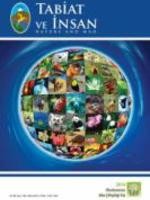Arap Bülbülü’nde (Pycnonotus xanthopygos) Bazı Seslerin Fiziksel Özellikleri ve İşlevsel Anlamı
Çalışmada, Arap bülbülü, Pycnonotus xanthopygos'un üreme mevsimlerinde kullandığı bazı ötüşlerin fiziksel özellikleri, bu ötüşlerin hangi durumlarda kullanıldığı ve ne anlama geldiğinin belirlenmesi amaçlanmıştır. Sıklıkla sergilenen ötüşlerin teritoryal, lokalizasyon, alarm, yiyecek arama, selamlama ve dinlenme süreçlerinde 6 farklı sinyal şeklinde kullanıldığı belirlenmiştir. Sinyallerin taşıyıcı frekansı 1,27 (min) ile 5,35 (maks) kHz arasında değişmekte ve sinyaller arasında olduğu kadar şekil, hece sayısı ve elementler arasında da farklılıklar olduğu tespit edilmiştir. Arap Bülbülü’nün sergilemiş olduğu iletişim sistemi hakkında bilgi elde etmenin yanısıra, yerleşim alanlarında yayılış göstermesi ve dolayısıyla insana alışık olması itibariyle hem akustik hem de davranışsal konuları incelemek için iyi bir model tür olabileceği sonucuna varılmıştır.
Anahtar Kelimeler:
Pycnonotus xanthopygos, arap bülbülü, biyoakustik, vokalizasyon
___
- Aslan A, Griggio M, Hoi H, Erdoğan A, Kahraman NŞ, Kabasakal B (2017). How to cope in a changing environment, behavioural strategies of the Yellow-vented Bulbul (Pycnonotus xanthopygos): a field and experimental approach. TÜBİTAK project no: 212T111.
- Aslan A, A Erdoğan (2007). On the Distribution of the White-spectacled Bulbul in Turkey. Zoology in the Middle East, 41: 31-34. https://doi.org/10.1080/09397140.2007.10638224
- Aslan, A. (2005). The Bio-Ecology of the Yellow-vented Bulbul (Pycnonotus xanthopygos) Population in Turkey. PhD Thesis (unpublished), 217 pp.
- Andersson S (1989). Sexual selection and cues for female choice in leks of Jackson’s widowbird Euplectes jacksoni. Behavioral Ecology and Sociobiology, 25: 403-410. https://doi.org/10.1007/BF00300186
- Andersson S, Pryke SR, Ornborg J, Lawes MJ, Andersson M (2002). Multiple receivers, multiple ornaments, and a trade-off between agonistic and epigamic signalling in a widowbird. The American Naturalist, 160: 683-691.
- Aslan A, Erdoğan A (2004). The Distribution of the White-spectacled Bulbul (Pycnonotus xanthopygos) and influential factors on its distribution in Turkey. 1st International Eurasian Ornithology Congress. Abstract Book, 11 p.
- Aslan A, Albayrak T, Tunç MR, Erdoğan A (2004). Antalya Kuşları ve Halkalama Çalışmaları (Ringing studies and birds of Antalya). Tabiat ve İnsan (Nature and Man) 2: 36-49.
- Brunton D, Li X (2006). The song structure and seasonal patterns of vocal behaviour of male and female bellbirds (Anthornis melanura). Journal of Ethology. 24: 17-25. https://doi.org/10.1007/s10164-005-0155-5
- Catchpole CK, Slater PJB (1995). Bird Song: biological themes and variations. Cambridge University Press, Cambridge.
- Catchpole CK (1979). Vocal Communications in Birds. The Institute of Biology’s Studies in Biology no.115, Edward Arnold Limited, London.
- Collias NE (2000). Vocal signals of the Village Weaver: a spectrographic key and the communication code. The Condor, 102: 60-80. https://doi.org/10.1093/condor/102.1.60
- Erdoğan A, Sert H, Vohwinkel R, Prunte W, Albayrak T, Aslan A, Tunç MR (2003). Manavgat/Titreyengöl Kuş Halkalama Çalışmaları (Bird ringing studies at Manavgat/Titreyengöl). Tabiat ve İnsan (Nature and Man), 1: 19-25.
- Ficken, M.S. & J. Popp (1996). A comparative analysis of passerine mobbing calls. The Auk 113: 370-380. https://doi.org/10.2307/4088904
- Klump GM, Shalter MD (1984). Acoustic behaviour of birds and mammals in the predator context. Ethology, 66: 189-226. https://doi.org/10.1111/j.1439-0310.1984.tb01365.x
- Kroodsma DE, Miller EH (1996). Ecology and Evolution of Acoustic Communication in Birds. Ithaca: Cornell University Press.
- Kumar A (2003). Acoustic communication in birds: Differences in songs and calls, their production and biological significance. Resonance 44-55.
- Kumar, A. (2004). Acoustic communication in the Red-vented Bulbul Pycnonotus cafer. Annals of the Brazilian Academy of Sciences, 76 (2): 350-358.
- Kumar A, Bhatt D (2000). Vocal signals in a tropical avian species, the Red-vented Bulbul Pycnonotus cafer: their characteristics and importance. Journal of Bioscience, 25 (4): 387-396. https://doi.org/10.1007/BF02703792
- Leader N, Wright J, Yom-Tov, Y (2000). Microgeographic song dialects in the Orange-Thufted Sunbirds (Nectarina osea). Behaviour, 137: 1613-1627.
- Lloyd P, Hulley PR, Craig AJPK (1996). Comparisons of the vocalizations and social behaviour of southern African Pycnonotus bulbuls. Ostrich, 67: 118-125. https://doi.org/10.1080/00306525.1996.9639696
- Marler, P. (2004). Bird calls-their potential for behavioural neurobiology. In: Behavioral Neurobiology of Birdsong (Eds., H.P. Zeigler and P. Marler), Annals of the New York Academy of Science, 1016: 31–44. https://doi.org/10.1196/annals.1298.034
- Mullarney KL, Svensson L, Zetterström D, Grand PJ (1999). Collins Bird Guide. Harper Collins, London.
- Roselaar CS (1995). Songbirds of Turkey. An atlas of biodiversity of Turkish passerine birds. GMB, Haarlem.
- Seddon N, Tobias JA, Alvarez A (2002). Vocal communication in the Pale-winged Trumpeter (Psophia leucoptera): repertoire, context and functional reference. Behaviour, 139: 1331-1359.
- Sharp SP, Hatchwell BJ (2006). Development of family specific contact calls in the Long-tailed Tit Aegithalos caudatus. International Journal of Avian Science,71(5):1039-1046. https://doi.org/10.1111/j.1474-919X.2006.00568.x
- Sotthibandhu, S. (2003). Territorial defence of the Red-whiskered Bulbul, Pycnonotus jocosus (Pycnonotidae), in a semi wild habitat of the bird farm. International Journal of Avian Science, 25 (5): 553-563. https://doi.org/10.1111/j.1474-919X.2006.00568.x
- Yamasaki S (2006). Taxonomic status of populations of the Light-vented Bulbul Pycnonotus sinensis (Gmelin 1789) (Passeriformes: Pycnonotidae) in Taiwan and the Southern Ryukyus. Zoological Studies, 45 (2): 168-179.
- Wilson EO (1980). Sociobiologia. Omega, Barcelona.
- ISSN: 1302-1001
- Başlangıç: 2010
- Yayıncı: Türkiye Tabiatını Koruma Derneği
Sayıdaki Diğer Makaleler
Neozoa ve Neophytes - Dost mu Düşman mı?
Mahmuzlu kızkuşu (Vanellus spinosus)’nda dişi ağırlığı, yumurta ve yavru ilişkisi
Üç Kuğu türünün (Cygnus sp.) Türkiye'deki popülasyon durumu ve yayılışları
Kalender ARIKAN, Levent TURAN, Muharrem KARAKAYA
Arap Bülbülü’nde (Pycnonotus xanthopygos) Bazı Seslerin Fiziksel Özellikleri ve İşlevsel Anlamı
